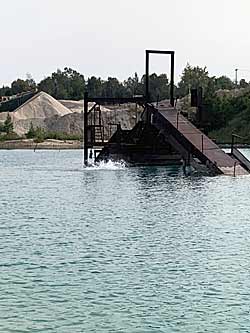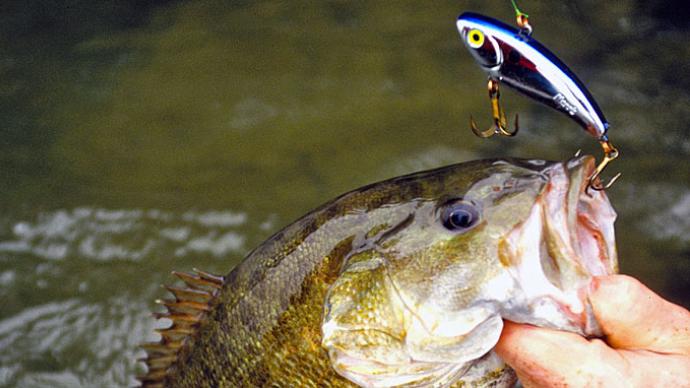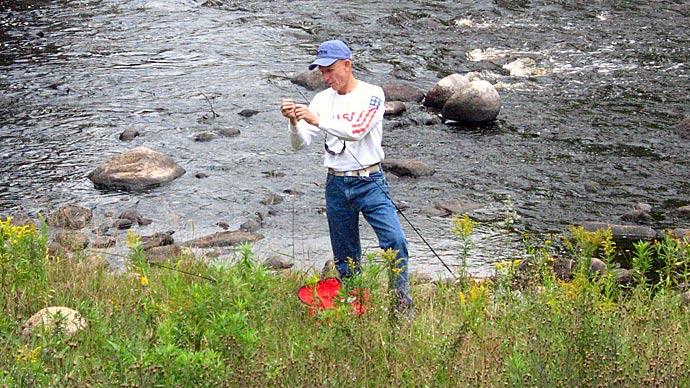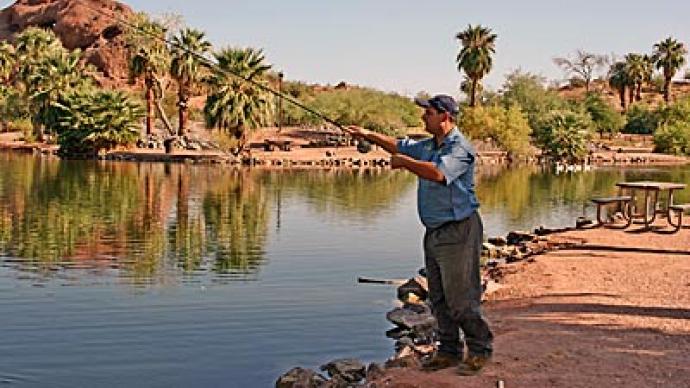
One of the most significant benefits of quarry and pond fishing is that they are so accessible. Almost anywhere you live, a short drive or even a walk will get you to a fishable pond or quarry. Most of them are small enough to fish from shore by simply walking around the edge, so you can throw a search bait as you go and pin down the current conditions reasonably quickly.
Colin Lasook of Ontario, Canada, often fishes the many quarries around his home. Since the water table where he lives is only about thirty feet deep, quarries tend to begin to fill up and become unusable for quarrying sooner rather than later. “Sometimes there may be several of them right next to each other,” Colin says, “because as one hits the water, they just move next to it and start over.”
These quarries are more than just a hole filled with water. Quarrying is usually done in a pattern, cutting and removing stone to a certain depth, then digging deeper when the stone edges are reached. This creates giant stair-steps around the entire pit; those ledges are great places to find bass. As the stonecutters go deeper, they make a road for the equipment to get down, and those roads generally spiral around the quarry and are composed of crushed stone, sand, etc. These roads are ideal spawning grounds for bass.
Most of the quarries near Colin are very clean and clear, with steep sides. He says he’s more likely to find bass in the quarries with darker water and trout in the ones that are clear blue. Some of the quarries, he says, are right next to the road – like they just dug a test pit there and then left. “The quarries that are harder to get to are usually the ones that have better fish,” he says, “and sometimes there will be two quarries in a row, but one will be better than the other.” Older quarries also seem to have better fish, he says. How the fish get in, there is a bit of a mystery. Colin speculates that either people are stocking them on the sly, or fish get washed in by floods. Fish is the only way to find out if a quarry or pond is suitable for fishing.
How Colin Fishes Quarries
Colin likes to walk around a new quarry to get the lay of the land. He says there isn’t much contour in a quarry, so he usually concentrates on fishing the upper twenty feet of water. Sometimes you can see rockslides or ledges from the quarrying activity. Some quarries may even have submerged equipment in them as if they filled up too quickly for the company to get the machines out.

Like a trout fisherman, Lasook is stealthy as he makes his way around the quarry. “The water is so clear that they can see you, so I try not to get too close to the edge or make a lot of noise.” He stays ten to fifteen feet from the edge and casts out past the edge of the first ledge if he can. “The quarry fish are savvy,” he says, “and if they see you, they won’t bite. I sort of tiptoe up and start fishing before they can see me.” This means tying up and being ready to cast before getting close to the edge. “I like to stand on rocks and try not to fall,” he says.
Plastics like crawfish, Senkos, and stickbaits are suitable, but the fish in quarries don’t see many large bait species, so bigger baits often don’t get bit. Big baits look unnatural to the quarry fish, so you need to downsize. Since the water is often so clear, natural colors are your best bet. He likes greens and browns and the Senkos that are green with red flakes. He uses spinning gear, a 2-piece rod he’s hiking in, and a long rod can get broken. Clear line in 8- to 10-pound-test, either fluorocarbon or mono, completes his rig. “Sometimes, I’ll use braid on older ponds because some of those older ones have more algae.” He travels light with just one rod, a hat and sunglasses, and a small pack with baits and other small gear.
Older quarries can have thick vegetation along the edges, and sometimes it overhangs the water, making an excellent place for fish to hang out. He sometimes uses a Berkley Pit Boss or Grass Pig close to the edges, flipping a 4-inch Pit Boss or fishing a wacky-rigged Berkley General. He uses the same light line, sometimes pitches right out to the middle, and lets the bait fall. “Those baits have lots of action, so you don’t even have to do anything to them,” he says. Again, he prefers natural green and brown colors. He says the bites are more curious if the bait isn’t natural-looking. Natural baits get eaten.

Since he doesn’t usually know how deep the fish are at first, he watches for visible structure as he walks around and fishes within twenty feet of the surface. “I figure there probably aren’t a lot of fish below twenty feet because there’s no food, so quarries are like a fish bowl – the fish just swim around and around the sides.” The fish seem to be in groups most of the time, he says, and if you catch one, you might catch five more right there. He says the bass don’t get very big in the quarries where he lives, and a five-pounder is a mythical creature. But no matter their size, bass are a blast to catch, especially on such light line.
“I think I saw a study once that said that a four-pound bass is twelve years old,” Colin says, “and a smallmouth bass over eighteen inches long could be ten to fifteen years old.” A few quarries he knows have shallow edges, and some seem to have more smallmouth than largemouth bass, but all that is information you get for yourself by fishing.
Colin enjoys investigating new quarries, and in the summer, some of them can have a lot of people enjoy the quarry by swimming and picnicking. “Now and then, I’ll get there, and there’ll be a hundred people there,” he says. People swim, cliff jump, and even put floats out on the water. “There are some quarries that you aren’t supposed to be in,” he says, “but the paths to them are so well-used that lots of people go there. So far, no one has asked me to leave,” he says, “but if they did, I would go.” If he’s found a pond he wants to try out and he can see the owner’s place close by, he’ll go and ask permission. Usually, they permit him if he promises to bring them a few fish.
“The thing about quarry fishing is that it isn’t done much,” Lasook says, “but when you go out and realize how much fun it is and how much easier it is than gearing up to go to the lake, you’ll ask yourself why you didn’t go before – you’ll make memories the very first time you go.”
About Colin:
Colin Lasook grew up on Lake Erie and fishes there nearly every weekend, enjoying quarry and pond fishing. He is working on a master’s in environmental science. He was recruited by Berkley when he was 18 and was one of eight Junior Ambassadors for Pure Fishing. He is now the Ambassador for Pure Fishing Canada and studying freshwater and the biochemistry of wetlands.
BassResource may receive a portion of revenues if you make a purchase using a link above.




